Okay, fish on pizza is a controversial topic, but I say a sardine pizza is something you need to try. It’s heart healthy, less salty than anchovies, and simply delicious. Let’s give it a try!

A Sardine Pizza is also an option for those wishing to explore a Mediterranean Pizza. You can learn more about how this can be a part of a Mediterranean Diet on our article about Mediterranean Pizza here.
But Sardine Pizza? REALLY?
So before we really dive in, I have to admit – I was VERY skeptical about this pizza until I made it. Turns out, at the time of writing, this is my favorite that I’ve made! If you like fish, please give this wonderful pizza recipe a try!
What is Sardine Pizza?
Typical sardine pizza (if there is such a thing) is a Pizza Bianca – meaning white pizza and therefore not having tomato sauce. Instead, this pizza relies on the more delicate flavor of olive oil and the other toppings to enhance the sardines.
Is This a Healthy Pizza?
According to WebMD, sardines have a number of potential health benefits, including being a great source of omega-3 fatty acids, which they state can reduce the risk of heart disease and the likelihood of behavioral problems. They are also a good source of calcium, iron, and Vitamin D. WebMD goes on to list a number of other benefits of eating sardines, so what are we waiting for?
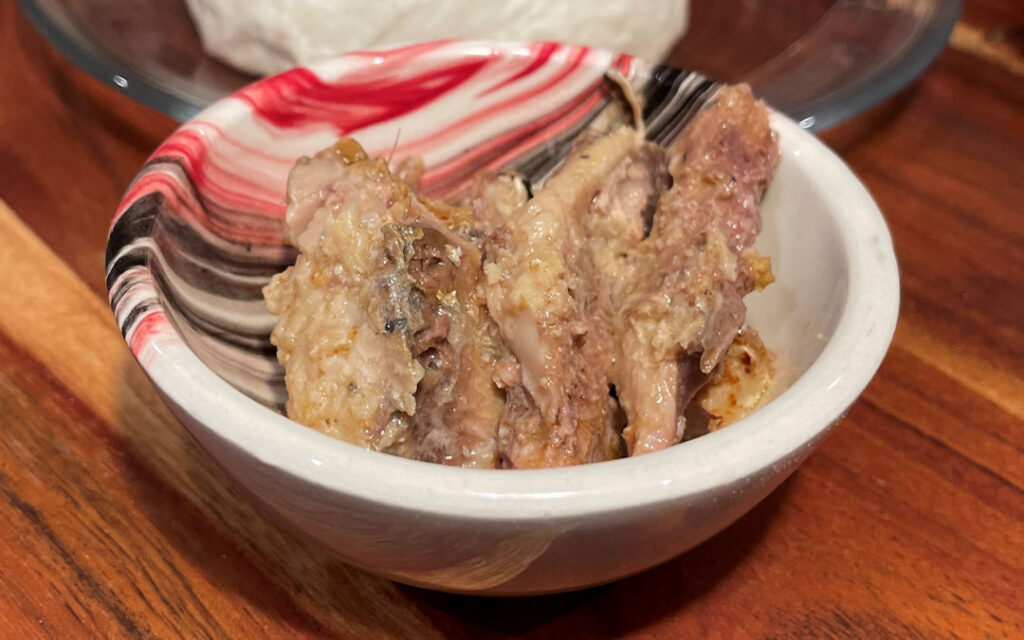
Of course you can choose to compliment your sardines with any toppings you wish, but I think they work best in a more Mediterranean combination. The Mediterranean Diet is considered a very healthy one and that’s where what we’re going to make.
Ingredients You’ll Need for Sardine Pizza
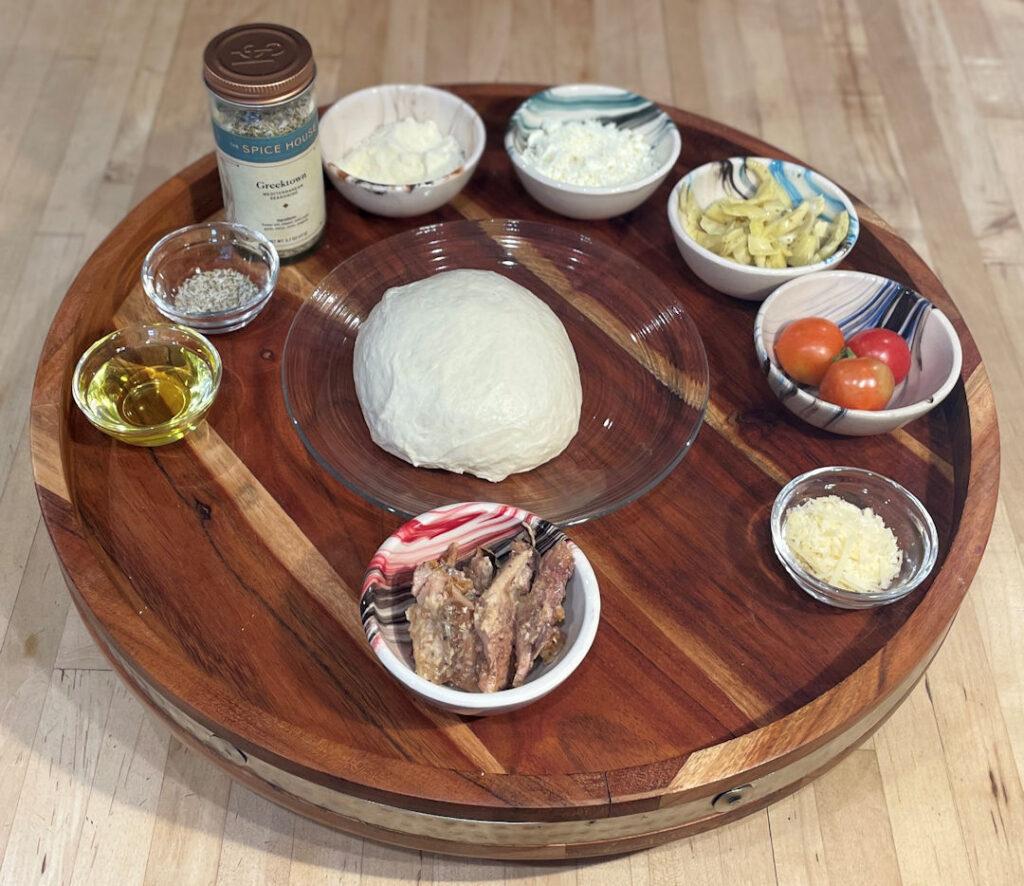
- 8-10 ounce pizza dough
- You can use a store-bought pizza dough
- You can also try our recipe for Easy Peasy Dough or our authentic Neapolitan Pizza Dough
- If you want to be more true to the Mediterranean Diet, then use a whole wheat pizza dough.
- 2 ounces of sardines, broken into pieces
- 2 ounces of olive oil (I recommend extra virgin olive oil)
- 2 tablespoons of flour (for stretching out your dough)
Optional toppings we’re going to use:
- 2 ounces of artichoke hearts (chopped and drained)
- 1.5 ounces of feta cheese
- 1 tablespoon of Parmesan cheese (grated)
- 3 cherry, grape, or cocktail tomatoes (sliced)
- 1 teaspoon of Greek seasoning (we prefer Spice House’s Greektown, but you can use a seasoning of your choice or even just a mix of salt, pepper, garlic, and oregano).
How to Make Sardine Pizza
Whether using homemade or store-bought dough, ensure it is at room temperature. Follow the instructions on the label if using store-bought, but generally, it should be out of the fridge for at least 30 minutes.
We cooked our pizza in our outdoor Solo Stove Pi (but you can of course use any outdoor pizza oven such as one from Ooni), transferring it to the oven on a wooden pizza peel. If using a peel, dust the peel with the flour and/or cornmeal. I like pressing it out into a circle on a silicone mat first, then transferring it to the dusted peel.
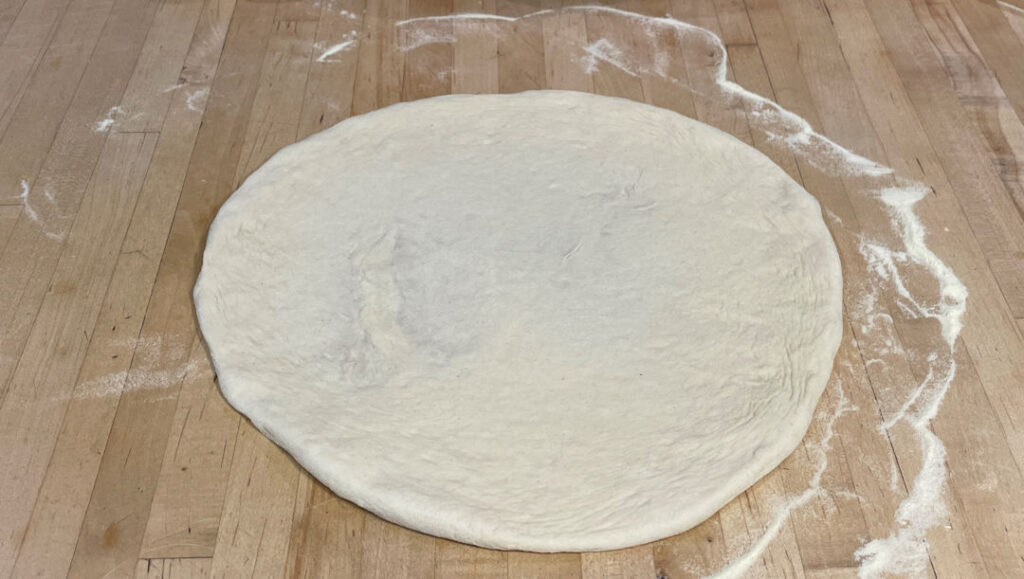
If using a conventional oven with a pizza pan, apply a coating of oil on the pan and on your hands. Using oiled hands, transfer the dough to the pan and press the dough into a circle on the pizza pan. Peel or pan; it is easier to transport the dough onto the pan or peel before it is topped.
Sprinkle the Greektown seasoning on the pizza dough. Then add the olive oil. Use a sauce brush to distribute the sauce and seasoning across the entire pizza dough leaving about 1″ at the edges.
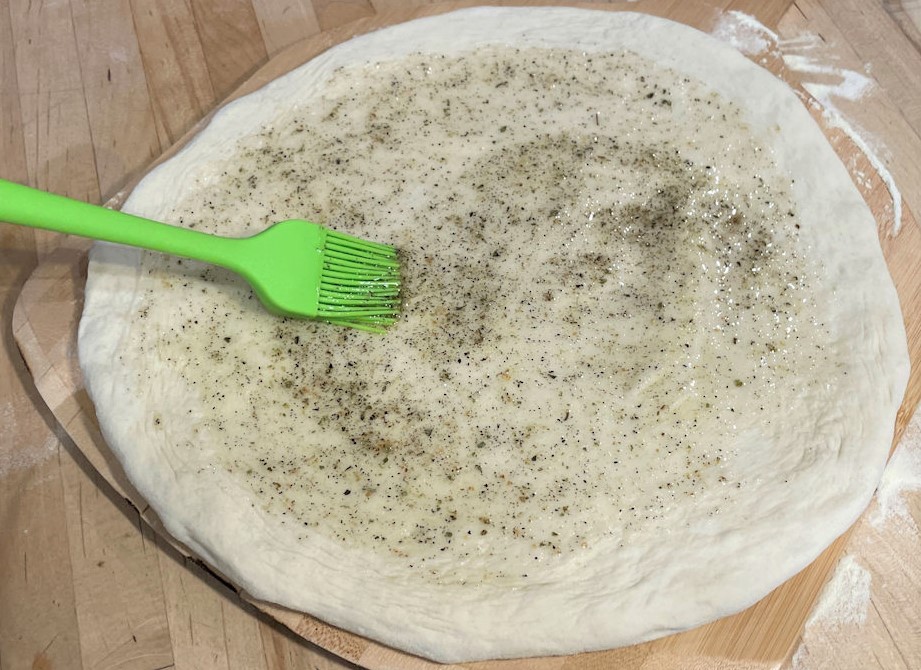
Top the pizza with each of the toppings distributing them evenly. Put the parmesan on first and put the feta cheese on last. You’ll likely enjoy the pizza more if you break the sardines into smaller pieces to distribute the flavor throughout the pizza.
If your artichoke hearts were packed in olive oil, there’s no reason not to drizzle the oil over the pizza (or save it for dipping the crust). Sometimes you’ll find sardines in oil too and you can do the same – but don’t do this if they are in water or brine (that will just make the dough soggy).
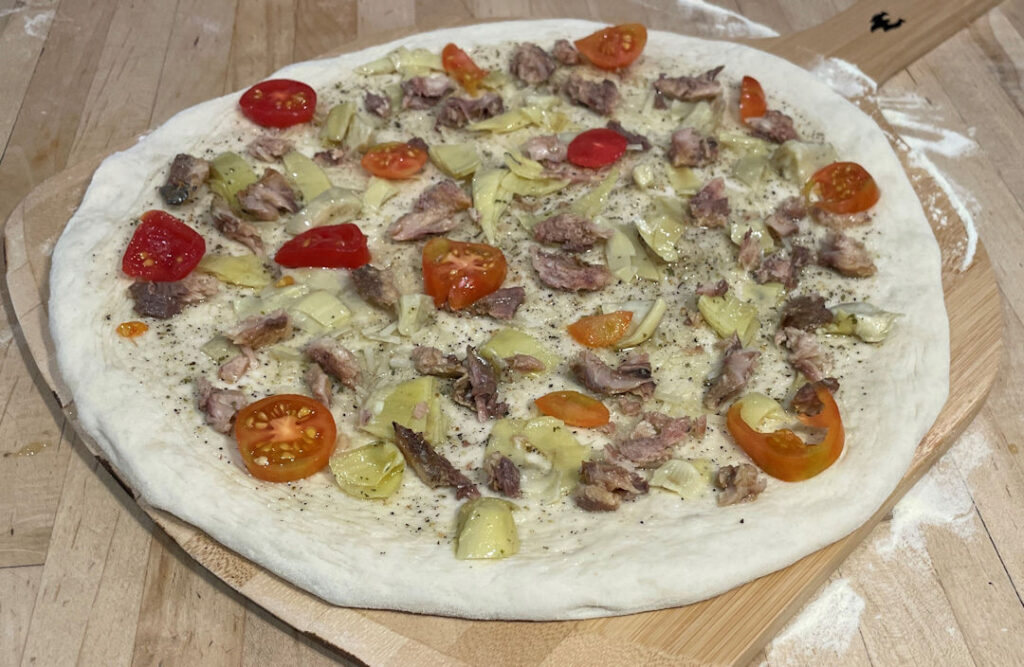
Top the pizza with your feta cheese last and head to the oven.
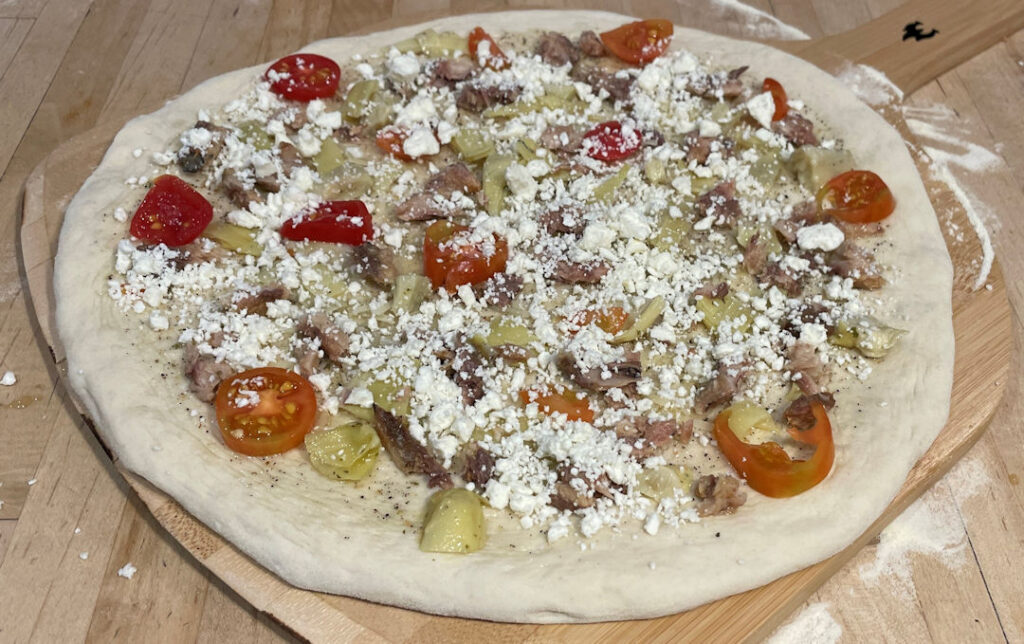
Sardine Pizza Cooking Instructions
We’re cooking with a Solo Stove Pi outdoor pizza oven, but naturally this recipe can be cooked in your oven on or off of a pizza stone or pizza steel. The biggest variation will be cooking time. If you’re using a wood burning outdoor pizza oven, it’ll take a little effort in managing the wood to get the proper temperature (especially if you’re also making and topping the pizza).
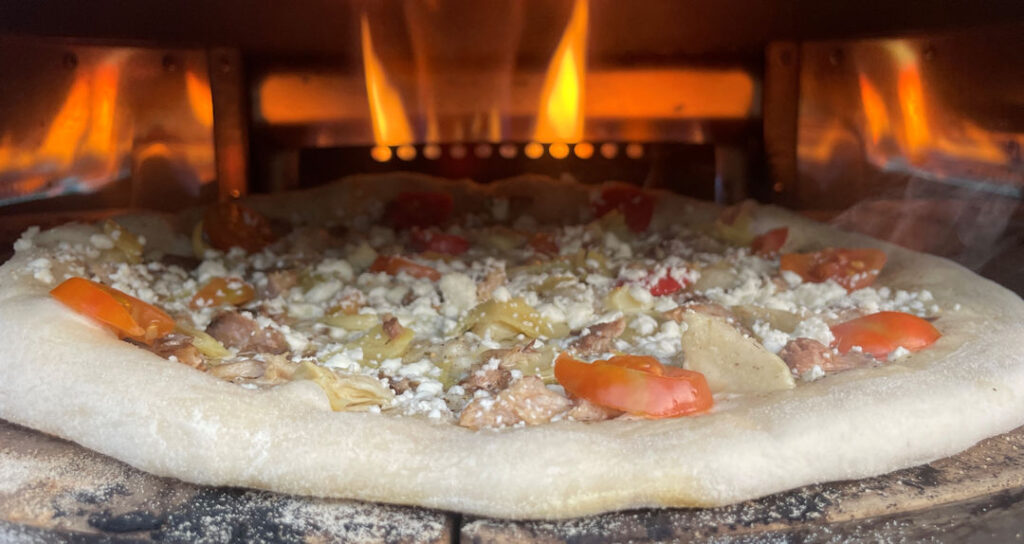
Note that if you are planning to use a pizza stone, this thin crust recipe is going to be hard to launch with a hot oven in front of you. You’re far better off starting the pizza on a pizza pan or a cookie sheet and then transferring to it to the pizza stone.
Cooking Time: Outdoor Pizza Oven
- Cook at ~850°F (using a Neapolitan pizza dough)
- 5-6 minutes
- Rotate a quarter turn 4 times.
- Rest for 3 minutes before cutting and eat immediately.
Cooking Time: Pizza Stone Indoor Oven
- Cook at 450°F on a pizza pan or cookie sheet
- 6 minutes, then rotate
- 6 minutes, then use a spatula to transfer the pizza to the pizza stone
- The top of the pizza should already be browning, in which case turn the oven off.
- Leave in oven for 5 extra minutes
- Remove and rest for 5 minutes before cutting and eat immediately.
If you are using a gas-heated outdoor pizza oven, just prior to launching, make sure the oven is not at max heat. That likely results in overcooking the top before the crust has cooked through. Turn it down!
Rotate the Pizza!
Using our Neapolitan Pizza Dough with the Solo Stove Pi or an Ooni Pizza Oven, get the stone to about 800°F-900°F degrees at the back (measured with an infra-red thermometer) and the front will generally be at or below 650°F – and that’s a decent difference from front to back. That’s why it’s important to rotate the pizza during cooking. Even in a conventional oven there is still generally variation, so it’s good to rotate your pizza at least once while cooking.

Once the pizza is launched, you’ll need to rotate. The first rotation is the most critical – the entire pizza needs to have firmed up enough that you can turn it without it losing its shape or tearing a hole – but you also can’t see the hottest side, so you don’t want it to burn. That’s why you don’t want the oven to be at maximum heat.
In a conventional oven, you probably only need to rotate your pizza once. In an outdoor oven, you generally want to rotate it a quarter turn at a time. Before that first turn, use your turner or peel and nudge the end closest to you to make sure it’s going to keep its shape.
Check the Bottom
Prior to pulling the pizza out, use your turner to lift the pizza and check how firm it is and how well done the bottom is. Make sure it has some stiffness and some browning.
Time to Eat
Remove the pizza and let it stand for three to five minutes before cutting (this will allow it to firm up). Cutting too soon will allow the fluids on top to trickle down and make the crust soggy.
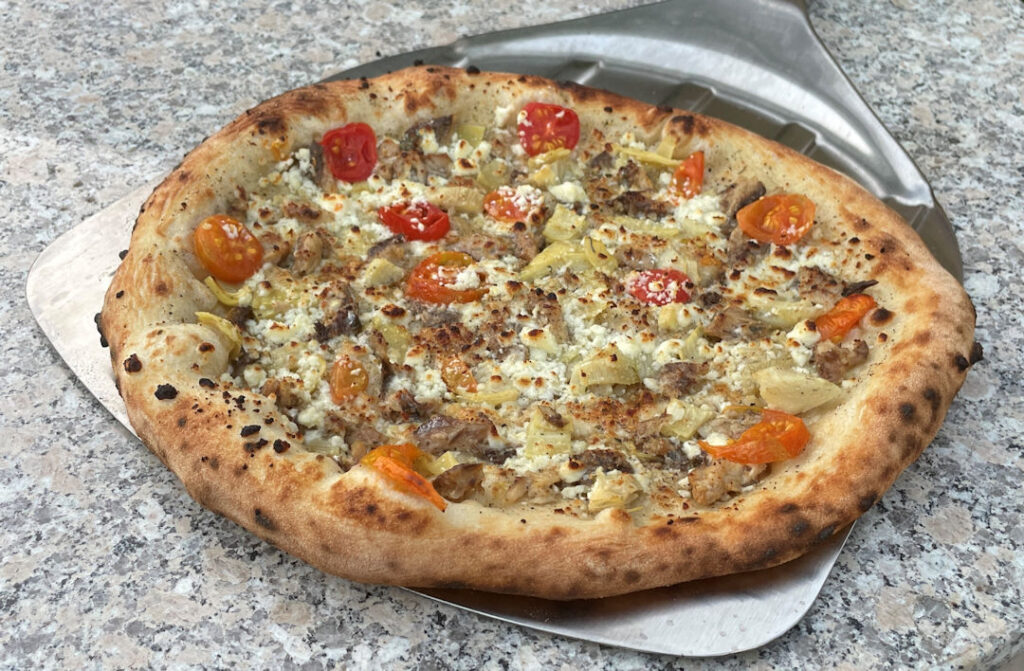
Cut, serve, and enjoy this delicious Sardine Pizza you’ve made yourself!

Substitutions and Variations
As discussed above, a Sardine pizza can but doesn’t have to follow the Mediterranean Diet. And you can deviate from this recipe to suit your tastes You can also:
- Use a whole wheat pizza dough
- Include other Mediterranean foods like: chicken, gyro meat, or a sprinkling of Parmesan cheese
- You can also easily make this dish vegetarian (just remove the fish) or even vegan.
- You can use tomato sauce.
- You can serve with a dip for the crust like hummus or more olive oil.
Additional Tips for Making Sardine Pizza
- If you use a thicker crust pizza dough like our Easy Peasy Dough, you’ll want to cook it at a lower temperature in an outdoor oven (650°F to 700°F)
- I like using a silicone mat to press my pizza dough out if it is going on a peel. It’s hard for things to stick to it, yet easy to clean. I like this one because it outlines the circumference of the pizza.
How to Store It
How to Reheat It
If the pizza is from the fridge: Preheat the oven to 350 degrees. Once it reaches temp, place it on a pan or the pizza stone for 15 minutes. Alternatively, you can heat the slices in a skillet on the stovetop – no need to preheat the pan! Place the skillet on the stovetop over medium heat, place the pizza in, and let heat for 6-8 minutes.
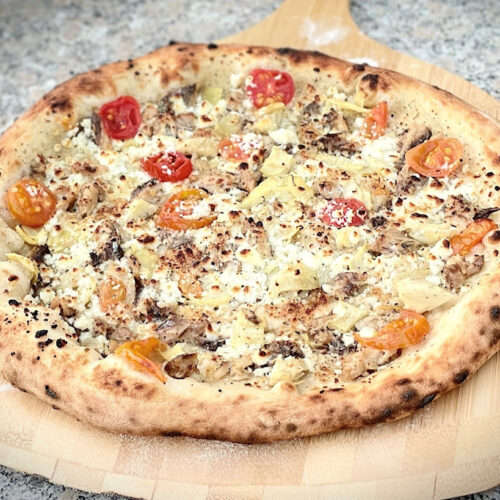
Sardine Pizza
Equipment
- 1 Outdoor pizza oven Optional
- 1 Pizza Peel Optional
- 1 Basting Brush
- 1 Pizza pan or cookie sheet (if cooking in regular oven)
- 1 Pizza Cutter
Ingredients
- 2 ounces sardines broken into pieces
- 1 dough ball (such as our authentic Neapolitan Pizza Dough) This recipe assumes a 9-10 ounce dough ball making a pizza between 11-12 inches in diameter.
- 2 tablespoons flour for work area (semolina preferred)
- 2 tablespoons olive oil extra virgin
- 1 teaspoon Spice House's Greektown Seasoning (salt, pepper, garlic powder, oregano)
- 3 cherry tomatoes sliced
- 2 ounces artichoke hearts chopped and drained
- 1.5 ounces feta cheese crumbled
Instructions
- Preheat the oven
Prepare Your Dough
- Stretch/roll out the pizza dough to make a pizza ~12 inches in diameter
- (If you use a pizza pan, add thin coat of olive oil).
- If using a pizza peel, flour the peel so the dough won't stick.
Prepare the Ingredients
- Have all of your toppings ready to apply. Break the sardines into small chunks. Slice the tomatoes.
Prepare the pizza
- Place the dough on the peel or pan. You may need to straighten the edges with your fingers.
- Distribute your Greektown seasoning evenly over the pizza leaving about 1" of the outside edge without.
- Pour the olive oil onto the center of your pizza dough.
- Use a brush to spread the olive oil evenly across the entire pizza and evenly distributing both the oil and the seasoning.
- Sprinkle the artichoke hearts, sardine bits, and feta cheese evenly over the dough. If there is leftover olive oil from the artichoke hearts (or sardines), you may choose to add a little more oil drizzled over the top or keep it as a dip for the crust after.
Cooking Time: Pizza in an Indoor Oven
- Cook at 450°F on a pizza pan or cookie sheet
- 7 minutes, then rotate
- 7 minutes, then use a spatula to transfer the pizza to the pizza stone
- The top of the pizza should already be browning, in which case turn the oven off.
- Leave in oven for 5 extra minutes (on a pizza stone if you have one)
- Remove and rest for 5 minutes before cutting and eat immediately.
Cooking Time: Outdoor Pizza Oven
- Cook at ~900°F (unless the crust is thicker like our Easy Peasy dough, in which case >650ºF)
- 4-6 minutes
- Rotate a quarter turn 4 times.
- Remove and rest for 3 minutes.
- Cut then serve immediately.
Notes
Nutrition

Todd’s cooking skills have revolved around the grill since about age 12, when he developed a love for grilling and took over for Mom at the BBQ. He worked at Wendy’s and at Earl’s Tin Palace (a restaurant chain in Canada) but never really did any sort of baking…until he and Heather started making pizza together! Now he’s often making dough in the mornings and pizza in the evenings.
